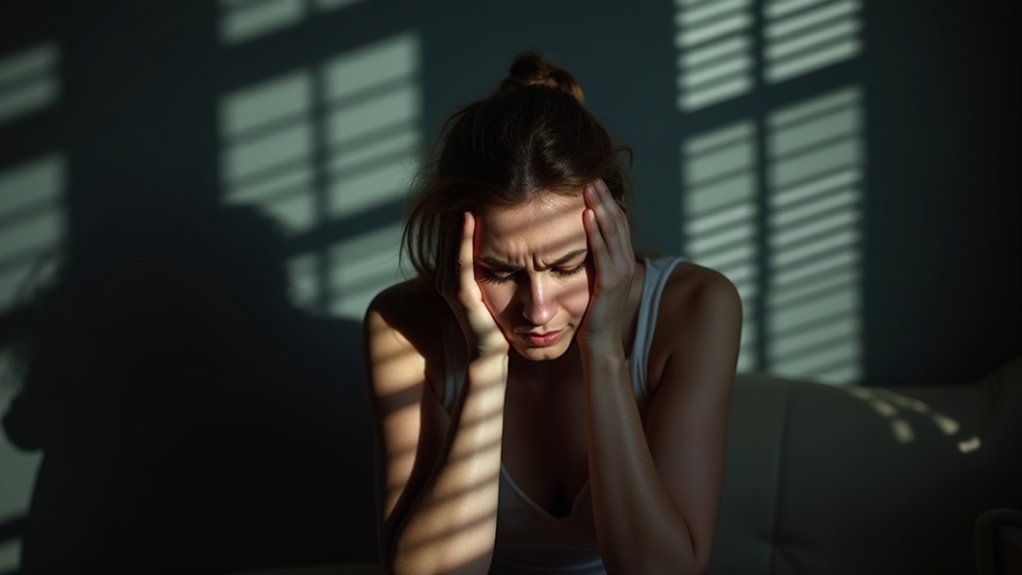Depression headaches feel like a tight band squeezing around your skull, creating constant pressure and a dull ache that extends from your forehead to the back of your head. You’ll notice increased tension in your neck and scalp muscles, with pain that intensifies during emotional stress or anxiety. These headaches typically develop gradually and can persist for days or weeks, often accompanied by light sensitivity. Understanding the mind-body connection reveals deeper insights into managing these symptoms effectively.
The Physical Sensation of Depression-Related Head Pain

Depression-related headaches manifest primarily as a persistent tension-type discomfort, characterized by a band-like pressure that encircles the skull and concentrates around the temples and forehead. You’ll notice these physical sensations differ distinctly from other headache types, lacking the sharp, throbbing qualities associated with migraines. Sleep patterns often become irregular, leading to disrupted rest cycles.
The pain descriptions typically include a constant dull ache that extends across your forehead and can radiate to the back of your head. You’ll experience tension in your neck and scalp muscles, which contributes to the overall discomfort. This pattern often creates a vicious cycle of pain where headache symptoms intensify depression, leading to increased head pain. This discomfort often intensifies during periods of emotional stress and anxiety. Unlike migraines, these headaches develop gradually without sudden intensity spikes. The pain remains localized to specific regions rather than spreading diffusely across your head, and you may notice it’s particularly pronounced when your neck muscles are strained.
Common Patterns and Duration of Depressive Headaches
When experiencing depressive headaches, you’ll typically notice predictable patterns that can persist for days or even weeks at a time. These chronic patterns often correlate directly with your depressive episodes, creating a cyclical relationship between emotional state and physical discomfort. Research shows that biological brain chemistry, particularly involving neurotransmitters like serotonin, plays a significant role in both depression and associated headaches. Depression-related headaches are characterized by dull forehead pain that can become persistent and troublesome. Many patients experience light sensitivity which can further disrupt their daily activities and routines.
| Pattern Characteristic | Duration Impact |
|---|---|
| Emotional Stress | Days to Weeks |
| Sleep Disruption | Persistent Until Resolved |
| Depression Flare-ups | Throughout Episode |
| Muscle Tension | Continuous During Stress |
| Comorbid Conditions | Variable Length |
Your headache triggers can include emotional distress, sleep disturbances, and heightened anxiety, which may intensify during particularly challenging periods. The pain typically manifests as a tension-type headache that’s mild to moderate in intensity, though it can become more severe during prolonged depressive episodes. Understanding these patterns helps in anticipating and managing symptoms effectively.
Understanding the Mind-Body Connection

Depression and headaches share intricate biological pathways through your brain’s pain-processing and emotional centers, including the limbic system and prefrontal cortex. Your body’s stress response triggers a cascade of hormones through the HPA axis, causing both physical pain and emotional distress when you’re experiencing depression. The neurochemical changes in serotonin and dopamine levels directly affect how you perceive pain, creating a cyclical relationship between your emotional state and headache symptoms. Research shows that tension-type headaches are the most prevalent form of headache associated with depression and can significantly impact daily functioning. The interaction between the somatosensory cortex and emotional regulation areas in the brain helps explain why depression can intensify headache pain. Ancient healers recognized this connection, as Traditional Chinese Medicine emphasized the role of emotional balance in treating physical pain symptoms.
Brain-Pain Pathways Explained
Understanding how headache pain interacts with depression requires examining the intricate neurological pathways that connect physical discomfort to emotional distress. Brain structure changes occur through neuroplasticity, while neurotransmitter interplay between serotonin and norepinephrine regulates both pain signals and mood. Research shows that chronic stress exposure contributes significantly to both headache severity and depressive symptoms. The relationship between pain and mood becomes more complex as psychogenic factors can intensify headache symptoms without clear physical causes. Studies indicate that dopaminergic activity in the brain significantly decreases during chronic pain states.
| Brain Region | Function in Pain-Depression |
|---|---|
| Locus Coeruleus | Controls pain sensitivity and emotional response |
| VTA | Integrates pain with reward circuits |
| Default Mode Network | Amplifies emotional pain processing |
| Anterior Cingulate | Modulates pain perception and mood |
Your brain’s pain processing system involves complex interactions within these regions. When you’re experiencing depression, these pathways can amplify headache intensity through altered connectivity and neurotransmitter function. The default mode network becomes hyperactive, creating a feedback loop that strengthens both the emotional and physical components of your headache pain.
Stress Hormones Trigger Headaches
Stress hormones serve as powerful biochemical triggers in the development of depression-related headaches through multiple neurobiological pathways. When you experience stress, your hypothalamic-pituitary-adrenal (HPA) axis activates, releasing cortisol and initiating complex stress hormone interactions that can intensify head pain.
These cortisol headache effects emerge through several mechanisms: Your raised cortisol levels constrict blood vessels before triggering rapid dilation, while simultaneously activating pain-sensitive pathways in your brain’s dura mater. You’ll also experience PACAP38 release, which binds to MrgprB2 receptors in mast cells, releasing pro-inflammatory substances that amplify pain signals. During prolonged stress, your serotonin levels fluctuate abnormally, further destabilizing vascular tone and increasing your susceptibility to headaches. The sudden stress reduction period often leads to these intense headaches, particularly within six hours of the stress decline. Much like hormonal fluctuations during menstruation can trigger migraines, this biochemical cascade creates a self-perpetuating cycle of stress-induced head pain. These symptoms can be particularly severe in one in seven people who have a genetic predisposition to migraines.
Emotional Impact on Pain
The intricate relationship between emotions and physical pain forms a powerful feedback loop in depression-related headaches. When you’re experiencing depressive symptoms, your brain’s pain perception shifts, making headaches feel more intense and harder to manage. Your emotional state directly influences how severely you perceive the pain, with sadness and hopelessness amplifying discomfort. Nerve cell networks in your brain process both emotional and physical pain signals simultaneously.
Without proper emotional resilience techniques, negative thought patterns can intensify your headache symptoms, leading to increased social withdrawal and reduced access to pain relief mechanisms. Your anxiety levels may spike, triggering more frequent and severe headaches. Implementing effective coping strategies becomes essential, as chronic stress creates physical tension that perpetuates the headache cycle. Understanding this mind-body connection helps you recognize how emotional management directly impacts your physical symptoms.
Distinguishing Depression Headaches From Other Types

Patients experiencing depression-related headaches often face a diagnostic challenge when differentiating them from other headache types. Understanding the unique characteristics of depression-linked headaches can help you identify their distinct patterns and seek appropriate treatment.
Key distinguishing features of depression headaches include:
- Tension headaches present as a constant, band-like pressure rather than sharp or pulsating pain
- Migraine symptoms typically lack the aura phase common in classic migraines
- Pain patterns tend to be chronic and persistent rather than episodic
- Symptoms often worsen with emotional distress or poor sleep quality
- Pain frequently coincides with depressive episode fluctuations
Depression headaches differ from primary headache disorders through their strong correlation with mood symptoms and stress levels. You’ll notice they respond more effectively to combined treatment approaches targeting both physical pain and underlying depression.
Warning Signs and Early Symptoms
When depression manifests through headaches, recognizing early warning signs becomes essential for timely intervention and treatment.
You’ll likely notice the initial warning signs through unexplained headaches accompanied by muscle tension, particularly when they occur without clear physical causes. Early symptoms often include increased sensitivity to light and sound, along with persistent feelings of emptiness. You might experience difficulty concentrating and making decisions, while your sleep patterns may become disrupted.
Watch for behavioral changes such as social withdrawal and decreased interest in daily activities. Physical warning signs typically include fatigue despite adequate rest, changes in appetite, and heightened irritability over minor issues. If you’re experiencing recurring headaches alongside these symptoms, especially when they interfere with your routine or worsen with stress, it’s important to seek professional evaluation.
The Impact on Daily Life and Activities
Living with depression-related headaches considerably disrupts multiple aspects of daily functioning, from workplace performance to basic self-care routines. You’ll notice significant impacts across your lifestyle as symptoms intensify, affecting your emotional well-being and productivity. These challenges often create a cycle of relationship strain and social withdrawal.
- Your workplace efficiency decreases through increased absenteeism and reduced concentration
- Daily routines become harder to maintain, leading to self-care neglect and nutritional deficiencies
- Social interactions diminish as pain and fatigue limit your ability to engage with others
- Coping mechanisms like hobbies and exercise often get abandoned
- Sleep patterns become disrupted, further compromising your physical and mental health
The combination of these impacts requires thoughtful lifestyle adjustments and potentially professional support to manage both headache symptoms and associated depression effectively.
Emotional Triggers and Pain Intensification
When you’re experiencing depression, your heightened stress response can intensify headache pain through increased muscle tension and neurochemical changes. Your emotional state directly impacts pain perception, with anxiety and negative mood states lowering your pain threshold and amplifying headache severity. Depression-related stress triggers can initiate a cycle where emotional distress leads to headaches, which in turn worsen your mood, creating a self-perpetuating pattern of pain and psychological distress.
Stress Amplifies Pain Response
Chronic stress fundamentally alters your body’s pain response mechanisms through complex neurochemical changes. Your stress response triggers the release of norepinephrine and neuropeptides that intensify pain signals, while simultaneously disrupting natural pain modulation systems in your brain.
- Your nociceptors become hypersensitive through increased substance P and CGRP release
- Stress-activated sympathetic nervous system amplifies pain perception
- TRP channels become hyperexcitable, prolonging pain sensitivity
- Your central nervous system’s pain processing thresholds decrease
- Descending pain control pathways become impaired
This neurochemical cascade creates a self-perpetuating cycle where stress continually amplifies pain signals. The interaction between your emotional state and pain processing pathways leads to heightened sensitivity, making even mild discomfort feel more intense during periods of stress.
Mood Changes Trigger Headaches
Depression greatly alters your emotional landscape, creating a complex interplay between mood fluctuations and headache intensity. When you’re experiencing depressive episodes, emotional triggers can greatly amplify your headache symptoms. Your anxiety levels and feelings of hopelessness directly impact pain perception, while mood fluctuations disrupt normal pain thresholds through altered serotonin levels.
Your stress responses become heightened during periods of social isolation, limiting access to crucial coping mechanisms and emotional support networks. Persistent rumination patterns characteristic of depression can sustain headache cycles by prolonging physical tension. You’ll notice that emotional numbness or persistent sadness doesn’t just affect your mental state, these mood changes actively intensify and prolong headache durations, creating a challenging cycle that reinforces both physical and emotional distress.
Breaking the Cycle of Depression and Head Pain
Breaking free from the interconnected cycle of depression and headaches requires understanding their bidirectional relationship. You’ll need to implement both coping strategies and lifestyle changes to effectively manage these intertwined conditions. Integrated treatment approaches target both the physical and emotional aspects of your symptoms.
- Establish consistent sleep patterns to regulate neurotransmitter activity and reduce headache frequency
- Practice stress management techniques like CBT to reframe pain perception and emotional responses
- Maintain regular physical activity to boost mood-regulating chemicals and reduce muscle tension
- Follow a balanced nutrition plan that supports neurological health and stabilizes energy levels
- Build a support network to combat social isolation and strengthen your resilience against both conditions
These evidence-based interventions work together to disrupt the self-reinforcing cycle of depression and head pain, improving your overall quality of life.
Frequently Asked Questions
Can Depression Headaches Cause Permanent Damage to the Brain?
No, depression headaches don’t cause permanent brain damage. While you might experience discomfort and temporary symptoms, there’s no scientific evidence suggesting long-term structural damage to your brain. However, for ideal brain health, it’s essential to pursue appropriate headache treatment, as untreated chronic conditions can lead to increased stress sensitivity and potential mental health complications. Early intervention with proper medical care will help prevent the cycle of depression and headache symptoms.
Are Certain Age Groups More Susceptible to Depression-Related Headaches?
You’ll find that depression-related headaches affect different age groups distinctly. Adolescent vulnerability is particularly high due to hormonal changes, academic stress, and social pressures during puberty. Middle-aged adults face peak susceptibility due to increased life stressors and caregiving responsibilities. Elderly susceptibility is notable, often complicated by social isolation, polypharmacy, and chronic health conditions. Young adults also show significant risk due to career pressures and lifestyle factors.
Do Depression Headaches Feel Different in Men Compared to Women?
Yes, you’ll notice gender differences in how depression and headaches manifest. While men typically report more physical symptoms and exercise-related triggers, women often experience more intense pain influenced by stress and hormonal influences. Men tend to describe their headaches alongside other physical discomfort, while women report higher emotional distress. You’ll also find that men are more likely to attribute their headaches to external factors like work or environment.
Can Weather Changes Affect the Intensity of Depression Headaches?
While there’s limited scientific evidence directly linking weather to depression headaches, you might notice changes in pain intensity during weather shifts. Barometric pressure fluctuations and varying humidity levels could potentially influence your headache symptoms, though this connection isn’t conclusively proven. Your individual response may vary, and these weather-related effects are more commonly studied in migraines. It’s helpful to track your symptoms alongside weather patterns to identify personal triggers.
Are There Genetic Factors That Influence Depression-Related Headache Patterns?
Yes, your genetic predisposition greatly influences depression-related headache patterns. Research shows a 30% genetic correlation between depression and migraine, with shared genes affecting serotonin and dopamine pathways. You’re more likely to experience these headaches if you have familial patterns of both conditions. Your genetic makeup can affect how your brain processes pain and mood, particularly through genes like MAOA and CACNA1C that regulate neurotransmitter function.






